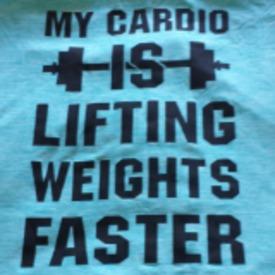Why set TDEE cut as goal instead of BMR?

azalais7
Posts: 187 Member
What is the rationale behind using the TDEE cut adjusted to average activity level as your calorie goal and not logging exercise less than 500 cal, rather than using appropriately-calculated BMR as the goal and logging all exercise?
0
Replies
-
Because just netting BMR doesn't give your body enough calories to support your activities for the rest of the day. BMR is what you burn if you're sleeping all day and not moving at all. Just netting BMR is too big of a cut and leaves your body wanting more, more, more.0
-
Thanks, gotcha. Keep forgetting about those breathing, etc. calorie expenditures!

I'm just worried about misjudging my daily net if I'm not logging daily exercise less than 500 (maybe because I don't trust myself yet to really do it every day). There are some days when I just walk half an hour, some days when I run a bit or lift, and some days when I don't do any exercise at all.
Would I be safer calculating my TDEE with light activity (e.g. assuming I'm going to do that daily half hour walk but not necessarily that I'm going to do something more) and using that cut as my goal, eating more if I end up exercising more?
If it helps, here are my stats, first with moderate activity and then with light:
Weight: 170 lbs
Height: 60 inches
BMR: 1488
Moderate Activity:
TDEE: 2306
-15%: 1960
Light Activity:
TDEE: 2046
-15%: 17390 -
I think part of my issue is that I really like logging that daily light exercise--it helps keep me motivated and gives me a sense of accomplishment. But if I go with the practice advocated here, I'm not supposed to log exercise unless it's a more significant expenditure, right?0
-
I'm sorry I don't have answers for you but I think you have highlighted a part of the program I did not understand before. So, I want to know about this idea of not logging any exercise that is below 500 calories burnt a day. Is that the same for everyone?
Where does the whole equation of taking your cut amount and subtract your BMR amount and eat any calories you have burnt over that fit in? In other words, in my case, I eat 2300, my BMR is 2100, that is 200 calories and I thought I should eat anything I burn above 200. Does it mean I miss understood and I should only eat anything I burn above 700 calories?
I too like logging all activities, even cleaning the house and stuff. I have stopped doing that right now because, now I only log actual exercise.
Depending on the answers that follow, I might find another site to log my exercise on in order to keep motivated.0 -
I say go with moderate. Most tend to underestimate their activity. Very few of us are actually lightly active. You can always adjust later if needed. Lots of trial and error type tweaking in this process.0
-
I have a bit of irregular exercise schedule so I log all my exercise to make sure it doesn't take me below my bmr. I eat enough to get me back over if it does.
Others though who have a more steady exercise schedule just enter 1 calorie burned so they can track their exercise minutes but not have it affect the numbers mfp displays
up to you which method you are comfortable with0 -
I have a bit of irregular exercise schedule so I log all my exercise to make sure it doesn't take me below my bmr. I eat enough to get me back over if it does.
Others though who have a more steady exercise schedule just enter 1 calorie burned so they can track their exercise minutes but not have it affect the numbers mfp displays
up to you which method you are comfortable with
Can you give me a practical example of how you do it. For example a day where you do eat back and a day you don't? My exercise is also erratic and I'd like to see how you do it.0 -
You can still log it but only pay attention to your calorie number like the poster above. Or log it as 1 calorie and just note what your burn is in the description or in the exercise note. Whatever floats your boat. The only time you really need to eat back exercise cals is if you have a monster burn that takes your net below BMR. I never had to pay much attention to that though because I've never been one crank out an hour of Zumba or whatever to get a burn big enough to net too low.0
-
Others though who have a more steady exercise schedule just enter 1 calorie burned so they can track their exercise minutes but not have it affect the numbers mfp displays
Brilliant! I think I'll try that, with a note indicating burn as rebekahgo suggests. Thanks!0 -
Can you give me a practical example of how you do it. For example a day where you do eat back and a day you don't? My exercise is also erratic and I'd like to see how you do it.
Say my cut is 2000 calories a day. I eat that everyday. My BMR is 1500. My regular exercise schedule has me burning 300 calories per workout. Nothing changes daily so long as that stays the same. One day I decide to take my dog for a 3 mile walk which may add say 250 calories burned. that would bring my net down to 1450.. its below my bmr so its too low, so Ill add in 150 calories or so to get me back over, and will eat 2150 that day.
make sense?0 -
Good example ^^^^^
I like doing examples for folks, but I was being lazy and not wanting to type it all out on my phone 0
0 -
Yes, that makes sense. That is what I thought I should do too. So, here is mine:
2300 - 200 calories burnt = 2100 - that is okay, I don't have to eat anything back.
2300 - 300 calories burnt - 2000 - I need to add 100 calories to get back to 2100.
I think what confuses me some days is that when you log exercise, it changes the goal amount immediately, so I cannot use the MFP end result - I will always have to add 200 to the end result that the MFP equation gives me?
Maybe when I log my exercise I will just subtract 200 calories from the equation to make it easier for me.
For example:
I have eaten 2300 for the day - I got all my meals in and reach my goal in food.
I exercised and burnt 300 calories, but I enter in only 100 calories.
In MFP it would state 2300 - 100 = 2100 and I can just use their final answer as my guide as to whether I have eaten enough.0 -
One other possible way to jerry-rig the MFP calculations that occurs to me is that I could set my goals as my TDEE cut minus the 160 calories I currently burn on that half hour daily walk (this is the exercise that would take me into the lower end of the moderate activity level) and log that and whatever else I might do, still eating to actual TDEE cut unless my expenditure dips below BMR (not likely to happen very often; I don't go for monster cardio sessions).
Does that make sense? Or am I talking myself in circles here?0 -
Yes, that makes sense. That is what I thought I should do too. So, here is mine:
2300 - 200 calories burnt = 2100 - that is okay, I don't have to eat anything back.
2300 - 300 calories burnt - 2000 - I need to add 100 calories to get back to 2100.
I think what confuses me some days is that when you log exercise, it changes the goal amount immediately, so I cannot use the MFP end result - I will always have to add 200 to the end result that the MFP equation gives me?
Maybe when I log my exercise I will just subtract 200 calories from the equation to make it easier for me.
For example:
I have eaten 2300 for the day - I got all my meals in and reach my goal in food.
I exercised and burnt 300 calories, but I enter in only 100 calories.
In MFP it would state 2300 - 100 = 2100 and I can just use their final answer as my guide as to whether I have eaten enough.
There are two places on MFP where it gives you your goal calories. The first is on the food tracker page. When you exercise that page does change your goals according to the calories burned and ups the calories goal. The other place is on your homepage. That does not change with exercise. I log all my exercise and I only look at my homepage to see how I'm doing. I only look at the food number and NET number. If I ever see my NET is less than BMR I eat to get back to BMR. I personally think people make it too difficult when it doesn't need to be.0 -
Just pay attention to the total number of calories you actually EAT... forget what the NET number says, UNLESS that number takes you below your BMR.
I have to eat 2800 cals a day. So I eat that, regardless if what I burn exercising. Since my BMR is 1000 cals less than what I eat, I rarely if ever have to worry about that..
I will have to pay more attention when I make my cut though, since that will take me closer to it.0
This discussion has been closed.




